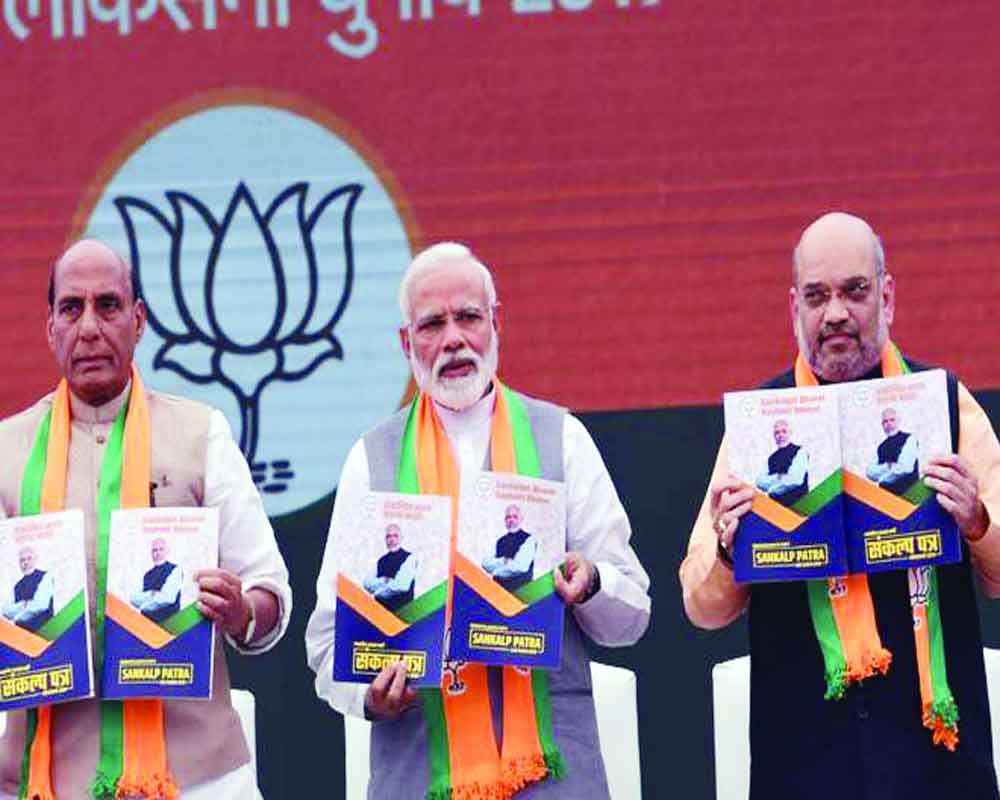The Bharatiya Janata Party (BJP) released its manifesto shortly before the Election Commission’s deadlines, a sign that it clearly doesn’t seem to be needing one. It is indeed of statistical import considering that all positions taken in it have been articulated by its leaders with some degree of consistency and sameness. In that sense, the manifesto is but a pallid status report of what the party in governance did, a balance sheet in its favour and a projection of what it needs to do in the future to meet, in its view, the only debt of expectation. Neither did it attempt a comparison with the vision document of the Congress, nor did it look back on its own. If in 2014, there was the dream of achche din and its deliverer in Narendra Modi, 2019 is about the charioteer who has paved his own road. If 2014 was about possibilities, 2019 is about a concrete action. If 2014 was tentative, emphasising the social paradigm of development, this one is hyperbolic, about the futuristic India of 2047. If 2014 was about the first among equals, 2019 is about one man, larger than life. And after the placatory moves of sabka saath, it is a more predatory stance of the sankalp of a One India. On its nationalist and persuasive terms, of course. The remaining gap of conviction is anyway being made up by Modi through a personal interface at rallies and television studios.
In a way, this manifesto actually addresses the party’s Hindutva core to the hilt without the visionary pretence of 2014. Now that polarisation has seeped into the societal trellis, the party has come out openly with an agenda that is frankly no longer dependent on the Ram temple. And the Pulwama-Balakot events have built up a hypernationalist sentiment that is pegged on the idea of India is under attack. So its manifesto merely puts on paper what its leaders have been saying so far, that the party, once in power, will abolish Article 370 and Article 35A that confer special status and protect local ownership rights in Jammu and Kashmir, the State that recently events have established as a hotbed of terrorism, especially of the exported kind. The removal of Article 35A is ostensibly to push for development and economic opportunities through outside investment. While the party had mentioned Article 370 in 2014 as well, it still went ahead and forged an impossible and asymmetric alliance with the Peoples Democratic Party (PDP) to work its way through governance. While that model failed, the rise in terrorism and the Pulwama attacks only made it easier for the BJP to argue why zero tolerance of victimhood meant that demonstrable action be taken against Pakistan and by extension its pawns in Kashmir. Whatever the legalities or complexities involved later, the BJP is hoping that by generating a debate and provoking extreme reactions from Kashmiris themselves, it can further coalesce the Hindu majority which has latent anxieties about a differential status. It is the reason why despite the massive protests and violence in the Northeast, the party has brought the Citizenship Amendment Bill back on the agenda, simply because it honours civilisational contiguity and wants to emerge as a champion of the larger Indic cause by offering to take back persecuted Hindu minorities from Islamic neighbours. In the process, it doesn’t mind risking the wrath of its new allies there. It is for this reason alone that the manifesto is silent on hate crimes, which have set the ambient temperature of a deeply fractured polity. Identity has clearly submerged livelihood issues and the manifesto just about skirts the elephant in the room — farmers’ distress and jobs. While there is no straightforward commitment on job numbers, a self-created trap of 2014 from which the party is yet to emerge, it does hold out the hope of creating new opportunities in 22 sectors. It has definitively pledged a “women in the workforce” roadmap to encourage companies to hire more women. Suitably vague and promising at the same time, one might add. There are a reiteration and the right noises of doubling farm incomes by 2022, taking healthcare forward with technology, judicial reforms, ease of living, education, science and so on. In short, a bouquet of promises and an argument why the party needs to be given five more years. This manifesto is certainly not trying to claim an intellectual high ground, just officially recording what has been said this past year. Neither is it a template for future governance. All it does is build a vote-catching narrative. The reality, as always, can change later.
Writer: Pioneer
Courtesy: The Pioneer








 OpinionExpress.In
OpinionExpress.In















Comments (0)